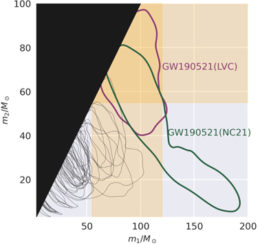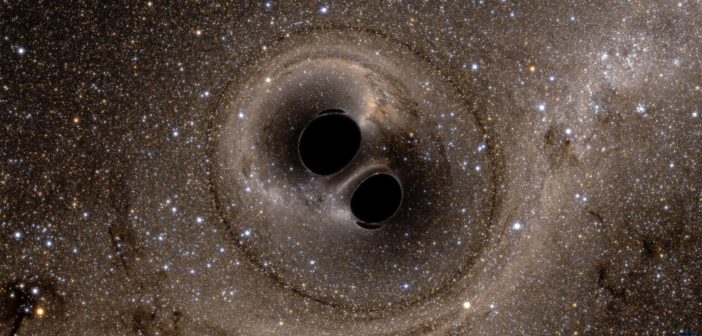One way for black holes to form is in supernovae, or the deaths of massive stars. However, our current knowledge of stellar evolution and supernovae suggests that black holes with masses between 55 and 120 solar masses can’t be produced via supernovae. Gravitational-wave signals from black hole mergers offer us an observational test of this “gap” in black hole masses.

The supernova SN 2016iet, which might be one of the first observed pair-instability supernovae. The lines show the placement of the instrument used to take spectra of the supernova. [Adapted from Gomez et al. 2019]
Black Hole Boundaries
You need a massive star to go supernova to produce a black hole. Unfortunately, extremely massive stars explode so violently they leave nothing behind! This scenario can occur with pair-instability supernovae, which happens in stars with core masses between 40 and 135 solar masses. The “pair” in “pair-instability” refers to the electron–positron pairs that are produced by gamma rays interacting with nuclei in the star’s core. Energy is lost in this process, meaning that there’s less resistance to gravitational collapse.
As the star collapses further, two things can happen. If the star is sufficiently massive, its core ignites in an explosion that tears the star apart, leaving no remnant. If the star is less massive, the core ignition causes the star to pulse and shed mass till it leaves the pair-production stage and its core collapses normally into black hole. The most massive black hole that can be produced in this scenario is roughly 55 solar masses, forming the lower end of the black hole mass gap.
On the other side of the mass gap, it’s theoretically possible for certain massive stars to collapse normally without entering the pair-production state, thus evolving into black holes with masses greater than 120 solar masses. The unique thing about these massive stars is that they are low metallicity, containing practically no elements that are heavier than helium.

The likely masses of the black holes involved in the 46 mergers considered in this study. The x-axis is the expected mass of one black hole and the y-axis is the expected mass of the other. Each contour represents a merger. However, the bolded green and purple mergers represent the same merger, GW190521, and correspond to values from two different studies. The orange regions represent the predicted mass gap. [Adapted from Edelman et al. 2021]
Mind the Gap, If There Is a Gap
Edelman and collaborators used two established model distributions of black hole masses to approach the problem. They also altered the models so the gap was explicitly allowed and so higher black hole masses could be explored without artificially inflating the rate of mergers above the gap. Edelman and collaborators then fit their models to data from 46 binary black hole mergers observed by the Laser Interferometer Gravitational-Wave Observatory and the Virgo interferometer.
Interestingly, the existence of the gap is rather ambiguous! One factor is the inclusion of the merger associated with the signal GW190521, which was likely a high mass merger whose component black holes straddle the mass gap. If the gap doesn’t exist, it’s possible that the unexpected black holes are formed by the merging of smaller black holes. On the whole, this result points to many avenues of study when it comes to pair-instability supernovae and black hole formation!
Citation
“Poking Holes: Looking for Gaps in LIGO/Virgo’s Black Hole Population,” Bruce Edelman et al 2021 ApJL 913 L23. https://doi.org/10.3847/2041-8213/abfdb3
